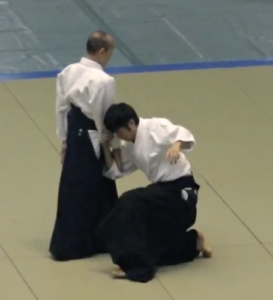Okay, so nobody is allowed in the dojo at the minute. Seems to be a worldwide thing. For weeks now all I’ve heard is the question, “How can I train at home?” Not being allowed in the dojo is the perfect time to work on that area that is massively neglected, fun to train, and just about everybody sucks at. No, not weapons.

Put The Weapons Away
There, I said it, stuck at home is not an excuse to do nothing but weapons. Sure, weapons can be important, but there are far more important things being neglected in the meantime. Things you can actually practice without a partner and that require much less space than weapons training. In a nutshell, you should be using this time to substantially improve your physical structure and basic movement. In other words, learn to stand up straight and move your body properly.
The importance of good posture in aikido is something that I really don’t think I can overstate. Everything in aikido just works better with good posture. Other benefits are that it can be one of the best self-defence techniques you’ll ever learn (it projects confidence and stops you looking like a weak victim relative to other people) and probably add 10-15cm to your height in the bargain. Learning to stand up straight takes time, practice, constant attention, and somewhere to stand up. This genuinely has the most minimal of space requirement. Even if every spare bit of floor space in your house is covered you can do this in the shower/bath.
Stand Up Straight
Standing up straight is harder than you think, takes more effort than you might imagine, and will train you in using muscles that you weren’t previously aware of. Most people I know have difficulty standing stationary for more than a few minutes, because it’s hard. Start working on this and it will improve your aikido when you’re back on the mats.
This postural work isn’t just when your standing though. It applies when you’re sitting, walking, cooking, basically anytime you aren’t lying down you should be working on your posture. The key to doing this is to constantly remind yourself that you’re slouching and to straighten up.
When working on this you may find that you encounter several aches and pains out of nowhere. There are numerous reasons for this and you’ll need to work those out for yourself. In my case my lower back started to develop deep pain. Turns out this is related to extremely tight hips with reduced rotational flexibility and working on that is sorting the back pain out (and my knee pain as well happily).
Remember Your Feet
Standing up straight is the first thing to work on then. I’ll admit that it gets boring really fast, so what else is there? Basic footwork. Horrendously neglected but one of the most important things we can do. It’s a bit like broccoli or brussel sprouts. We all know we should eat them but nobody wants to, because they’re gross. Same deal here, everyone knows they should train their footwork but nobody wants to, because it’s boring.
Common excuses range from, ‘there just isn’t the time’, to ‘we practice that while doing the techniques’. Here’s some good news, you’ve got the time now. Also, chances are you don’t practice it during the techniques because that isn’t how 99% of dojos train. The great example of this is kaiten nage. Most people do this without ever using a kaiten step. Just be honest and accept that we generally don’t do enough of the basic footwork.

There’s a lot of debate over what these movements are. I’ve encountered folk that say it’s only irimi. Nothing else exists. While I understand their argument I disagree. Besides, even if they’re right it doesn’t change the fact that you have to move your feet in different ways regardless of what you call the movement or what it results in.
The Basic Movements
There is a great deal of tai sabaki that you can do. From my training there are numerous steps that I practice on a regular basis as often as I can. It’s a surefire way to get weird looks at the bus stop and the queue at Starbucks but it’s worth it.
They are:
- Irimi Ashi
- Tsugi Ashi
- Sokumen Ashi
- Tenkan
- Kaiten
- Irimi Tenkan
I generally find that without these movements you just can’t perform the techniques. You’ll encounter difficulty getting your body into the right place at the right time. They aren’t difficult movements either, but they are easy to get wrong. There are many elements to them that have to be done correctly, the two most basic of which are that a) you have to stand up straight and b) everything must start and stop at the same time.
These are the things that are a requirement for all of your aikido. These are the most basic and fundamental things, before you even start to look at the techniques. The problem with the basics is that people never want to do them. They want to move on and get to the good stuff. The catch is that without this you can never master the good stuff and if you do manage to it will take you twice as long as it needed to.
Being unable to go to the dojo does not mean it’s a weapons free-for-all. It means you should practice the most basic movements and use the time to radically improve your aikido when you get back on the mats.
First learn to stand, then learn to walk.
If you can afford it, and would like to help out,
consider donating some brain fuel!
Also, if you enjoyed this post you can find further insights in this book.